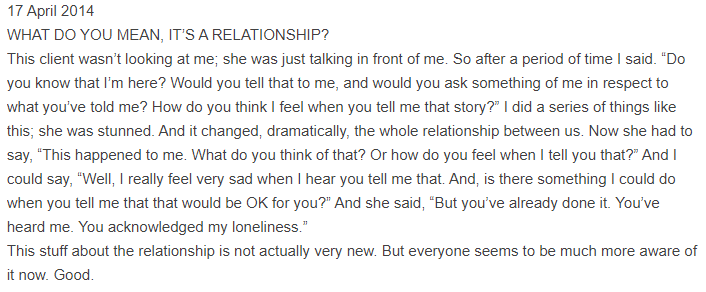
The Power of Active Listening in Therapy: Transforming Client Relationships
In the realm of therapy, the act of listening transcends mere auditory processing; it becomes an art form that, when practiced with intent, has the power to forge deep connections, foster healing, and transform lives. John Rowan’s insightful blog post, “WHAT DO YOU MEAN, IT’S A RELATIONSHIP?”, serves as a poignant illustration of this transformative power, highlighting the profound impact of active listening and engagement in therapeutic relationships.

This article delves into the essence of active listening, unpacking its significance and offering practical strategies for therapists and clients alike to cultivate more meaningful connections.
Understanding Active Listening
Active listening in therapy is not just about hearing words; it’s about fully engaging with the client’s verbal and non-verbal messages, understanding their content and emotions, and responding in a way that validates their experiences. This process requires the therapist to be fully present, employing empathy, patience, and genuine interest. Unlike passive hearing, active listening involves a dynamic exchange, where the therapist not only absorbs information but also reflects, clarifies, and explores deeper insights.
The Case of Transformation: John Rowan’s Approach
John Rowan shares a compelling narrative of a client who initially engages in a one-sided conversation, seemingly unaware of the therapist’s role as an active participant. By gently challenging this dynamic—prompting the client to acknowledge his presence and react to her stories—Rowan transforms the session into a dialogic exchange. This shift not only acknowledges the client’s loneliness but also empowers her to see the therapist as a co-navigator in her journey. Rowan’s approach exemplifies the essence of active listening, demonstrating its capacity to alter the very fabric of the therapist-client relationship.
The Impact of Acknowledgment in Therapy
The act of being truly heard and acknowledged can be incredibly validating for clients. It communicates respect, empathy, and genuine concern for their wellbeing. This acknowledgment helps clients feel valued and understood, fostering a safe space where they can explore their vulnerabilities without fear of judgment. The psychological benefits of this are manifold, contributing to a stronger therapeutic alliance and facilitating greater openness and honesty in sessions.
Building a Reciprocal Therapeutic Relationship
A reciprocal therapeutic relationship is characterized by mutual respect, understanding, and engagement. Such a relationship not only enhances the therapy’s effectiveness but also promotes a sense of partnership between the therapist and client. By employing active listening, therapists can encourage clients to become active participants in their healing process, thereby fostering a collaborative and empowering therapeutic environment.
Practical Strategies for Therapists
Therapists can enhance their active listening skills through various strategies:
- Maintain eye contact: Demonstrate your presence and attentiveness.
- Use body language effectively: Nodding and leaning forward can convey empathy and interest.
- Reflect and paraphrase: Show that you understand the client’s message by summarizing their key points.
- Ask open-ended questions: Encourage deeper exploration of the client’s thoughts and feelings.
- Validate emotions: Acknowledge and validate the client’s emotions without judgment.
Case Studies and Evidence
Beyond John Rowan’s narrative, numerous studies and personal accounts underscore the efficacy of active listening in therapy. These case studies reveal a common theme: when clients feel heard and understood, they are more likely to engage deeply in the therapeutic process, leading to more meaningful outcomes and personal growth.
Conclusion
The power of active listening in transforming client relationships cannot be overstated. By practicing active engagement, therapists can create a therapeutic space that fosters healing, trust, and profound connection. As we reflect on the insights shared by John Rowan, it becomes clear that the heart of therapy lies not in the spoken word alone but in the shared silence, the exchanged glances, and the mutual understanding that blossoms in the space between words.
FAQs
Q: How can I tell if my therapist is practicing active listening?
A: Look for signs of engagement such as eye contact, paraphrasing your words, asking insightful questions, and providing feedback that reflects a deep understanding of your concerns.
Q: Can active listening be learned, or is it an innate skill?
A: While some individuals may naturally excel at active listening, it is certainly a skill that can be developed with practice and training.
Q: Are there any resources for improving active listening skills?
A: Yes, numerous workshops, books, and online courses are dedicated to enhancing active listening skills, many of which are specifically tailored for therapeutic practices.
Active listening is more than a technique; it’s the foundation of meaningful therapeutic relationships. By embracing these principles, therapists and clients alike can unlock the full potential of the therapeutic journey.
